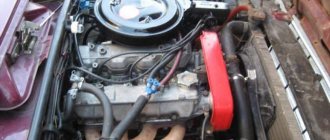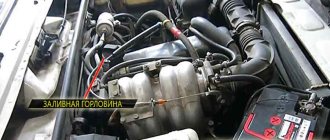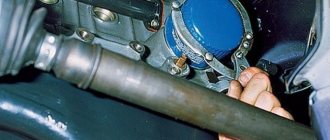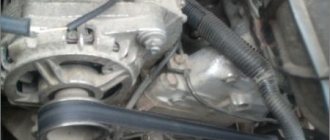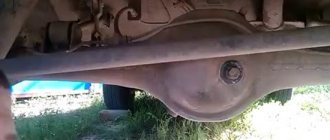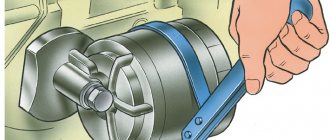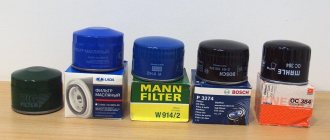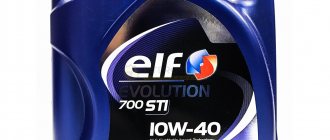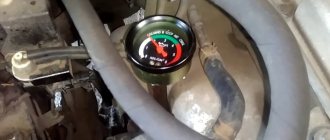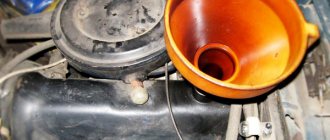06.12.2019
| (Votes: 1, Rating: 5) |
Issues discussed in the material:
- How to check engine oil level
- How much oil to pour into the engine
- What are the dangers of not adding enough oil to the engine?
- Why can't you put more oil in the engine?
A car enthusiast who independently maintains his car should know how much oil to pour into the engine. The need for a complete oil change arises regularly, and sometimes it is necessary to top it up to the required level. The volume of lubricant to be filled is individual for each engine.
Why is motor oil poured into the engine?
Synthetic motor oil
Before moving on to the main question, let’s determine why motor oil is poured under the hood of a car.
The fact is that during operation of the entire propulsion system, each of its metal elements is subjected to large temperature overloads: the rapid interaction of parts causes a high friction force, which has a destructive effect on the entire motor. The lubricant, which has a viscosity determined by the manufacturer, fills all the gaps between the elements, thereby activating the protective layer between them. Thus, the friction force is reduced, the temperature inside the housing returns to normal, and the entire unit operates with maximum service life.
Changing the engine oil
Carrying out vehicle maintenance without changing the oil fluid is not reasonable. It must be updated regularly, and the frequency of this procedure depends on many factors. For example, if you are planning to pour mineral oil under the hood, its beneficial effects, subject to a calm driving style, will disappear after 5-6 thousand kilometers. Do you like aggressive driving? The oil will last much less. Semi-synthetics last a little more than 8 thousand km, but high-quality synthetics, at best, will last the car no more than 15 thousand km. Thus, the replacement interval depends on the chemical base, driving style, operating conditions and the “age” of the car.
Intervals when you need to replace
The service book for the vehicle specifies the mileage after which the lubricant solution must be replaced. In the absence of intense operating conditions, driving on the highway outside the city, the mileage between lubricant changes can be up to 15,000 km. Operating vehicles in city traffic will reduce mileage to 9000-11000 km. But these data are not completely accurate, since the condition of the lubricant is influenced by several factors, which include:
- Type and quality condition of the fuel being filled.
- Power plant volume.
- The type of lubricant that was previously filled and its condition.
- The number of hours worked by the engine.
- Technical condition of the vehicle.
- Vehicle operating conditions and power plant operating modes.
These factors can change the quality of the lubricant. Loss of its characteristics by the lubricant will lead to rapid wear of the power plant. In such a situation, an analysis of the oil solution carried out in laboratory conditions can give an accurate answer about the quality of the lubricant and the need to replace it.
How is the fluid changed?
If you are faced with this task for the first time, here are some tips:
Engine oil drain
- Place the machine on a level surface. The ideal option is a garage pit or overpass.
- Before draining the fluid, drive the car around the city or on the highway for 30-40 minutes so that operating temperature is established inside the engine system.
- Change the oil filter every time you change the oil lubricant.
- Removing old oil is done by unscrewing the oil filler neck at the top of the engine and pulling out the drain plug under the car. The crankcase protection must be removed before replacement.
- It is not recommended to use devices for “express replacement” too often: they do not draw out the entire amount of lubricant, leaving part of the working fluid at the bottom of the unit. As a result, obsolete and new fluids are mixed, which leads to a decrease in engine life.
The need for replacement according to engine hours
The initial data is the stable average speed of the vehicle in the city and the manufacturer's recommendations for changing the lubricant. Let's say the speed in the city is 40 km/h, and the factory recommendations for replacement are 15,000 km.
To calculate engine hours, you need to divide the distance by the speed limit. In this situation, 15000/40=375 m/h. The obtained value means that after 375 operating hours of the power plant it is necessary to change the oil.
The API international standard has developed a summary table for replacing oils, depending on their type and service life.
| Type of oil solution | Operating hours |
| Mineral | 130-150 |
| SyntheticARI SJ/SHAPI SL/SMPolyalphaolefinsEsters | 230-250320-350370-400430-450 |
| Semi-synthetic | 230-250 |
How to check the oil level correctly
You need to measure the oil in any engine with a special oil dipstick, which is located in the sealed hole provided for it on the cylinder block. On the outside it has a plastic handle designed for easy removal of the tool. On its other side, immersed in the crankcase oil bath, marks for measuring the liquid level are reflected.
The liquid level is measured according to the following scheme:
Checking the engine oil level
- Place the car on a flat surface. This is important because If it is tilted, the liquid level may be distorted.
- remove the oil dipstick and wipe it with a clean cloth. The cloth should be free of dirt, woolen threads and other “trifles” that could subsequently get into the motor with the dipstick.
- lower the probe into the hole until it stops, wait 3-5 seconds and pull it out to the surface.
- We evaluate the result.
What level of engine oil should be in the engine? Regardless of the make of the car, the optimal level is considered to be in the middle, between o and “max”.
Important! The thickness of the oil layer should be measured on a cold or slightly cooled engine. If you were driving around the city all day, stopped and immediately decided to measure the level of fuel and lubricants, the result will be far from reality. The fact is that in a hot system, the oil is distributed among the working units, and is not concentrated in the lower part of the crankcase. Thus, the measurement will give incorrect information about its quantity. Let the car rest for 15-20 minutes, and after that, arm yourself with a dipstick.
By the way, after removing the dipstick, you can also evaluate the condition of the oil itself. If it contains foreign impurities, or its viscosity does not meet the required level, then it’s time to think about engine maintenance.
It is recommended to check the condition and level of the oil during daily use at least once a week. This measure will allow you to promptly prevent possible problems in the operation of the system and troubleshoot problems.
Why is the minimum engine oil level dangerous?
By measuring the volume of oil filled with a dipstick, you may find that the amount does not reach about. Why is this dangerous? The fact is that a low level of lubricating fluid cannot provide the necessary protection to all elements of the engine structure. In other words, the thickness of the oil film will be much less than required, and, perhaps, will not be able to form at all, thereby increasing the “dry” friction of the mechanisms. Rapid wear of working units, increased temperature inside the unit housing and crankshaft jamming are the main consequences of insufficient oil level.
Optimal oil level
A sharp decrease in fluid due to engine problems can be diagnosed by an oil pressure light located on the dashboard of any car. However, its activation occurs only if the leak is large-scale. If the housing lacks 200-300 ml of lubricant, you can only find out about this using a dipstick.
Symptoms of low oil levels are:
- the appearance of extraneous noise in the operation of the car,
- clearly audible knocking sound in hydraulic compressors,
- excessive increase in oil temperature and constant operation of cooling radiators.
If the reason for the low filling volume lies in a simple underfilling of oil fluid, then the solution is simple - add the required volume so that the oil level on the dipstick is between o and “max”. However, if you notice a regular lack of fuel and lubricants, then there is a hidden problem. You can diagnose it yourself or with the help of a car repair shop.
Why the engine “eats” oil: the main reasons
Engine oil in the engine
You cannot turn a blind eye to excessive oil consumption. Yes, you can constantly top it up, trying to delay the diagnosis, but such a measure will not solve the problem. Moreover, it can “transform” into expensive repairs. How to understand the reason for such a leak?
First of all, you should pay attention to the color of the exhaust gases. If there is a barely noticeable “blue” in them, then the problem here is in the oil scraper rings. Replace them with new ones, and the need to add oil will disappear.
If everything is fine with the rings, check the condition of the seals and gaskets. Their incorrect installation or simple wear can cause leaks, which can be detected under the valve cover or at the junction of the crankcase and the cylinder block.
The volume of oil in the engine may constantly decrease due to damage to the crankshaft or camshaft seals. In this case, the symptoms will be complemented by oil traces on the asphalt or garage floor after the car has been idle for a long time.
Oil filter
A noticeable disappearance of fuel and lubricants may also be associated with a discrepancy between its viscosity and the requirements established by the vehicle manufacturer. If the condition of the car is beyond doubt, the seals and gaskets are in working order, and oil consumption continues to increase, then the problem lies in its viscosity index. Take a look at your car's manual or contact an official representative of your car brand and find out what type of fluid needs to be poured under the hood.
In addition to the reasons listed, a regular decrease in fluid volume occurs due to the following malfunctions:
- leakage of the oil level sensor,
- the oil filter is not installed correctly,
- the drain plug is not inserted completely or is damaged,
- the level of ventilation of the system is insufficient to completely remove exhaust gases from the crankcase (excessive amounts of gas increase the pressure in the engine system, displacing the lubricant).
At first glance, it seems that the problems are not so critical, but long-term use of a car with such faults can negatively affect its service life. Therefore, it is easier to diagnose the car in a timely manner and carry out appropriate repairs if necessary, than to subsequently save money for the expensive restoration of an iron friend.
On a note! Problems with excessive oil consumption may not be a problem at all, but an acceptable norm. This situation occurs in cars equipped with turbocharging. It is recommended to check the lubrication level in a turbocharged engine every 5-7 days.
How many liters of oil do domestic car engines require?
If you can’t spoil the porridge with oil, then the car engine is a very capricious device in this regard. If the oil product is not added to the crankcase, the pump will not pump fully, and some of the cylinders will be dry. If you overfill it, the spark plugs will flood, the crankshaft will foam, causing the engine to stall. Or it won't start at all.
Most engines are picky about trying to mix different brands. Most often, such combinations lead to disastrous consequences, since additives added by manufacturers of different brands to improve the properties of oils react with each other, and the result of such reactions is unpredictable. As a result of chemical reactions of additives, viscosity deteriorates, an insoluble precipitate is formed, which negatively affects the lubricating properties and clogs the oil filter.
The volume of oil in the engine is 1.5-2.5 engine volumes, depending on its model and system.
Changing engine oil in GAZ cars
A veteran of the domestic automotive industry, the GAZ 21, although rare, is still found in its native open spaces. This car probably consumes the largest amount of lubricating oil - 5.5 liters.
Rolled off the assembly line of the Gorky Automobile Plant, it was replaced by the more modernized and elegant GAZ24, which was produced
- with engine type ZMZ-D24, and ZMZ-2401 in 1970-1986 with an engine capacity of 2.4 liters, requires 6 liters of oil to be poured into the engine;
- The ZMZ-2424 engine, twice as powerful as the previous ones and produced in 1985-1988, requires 8.7 liters to operate.
We recommend: What to do if the engine oil foams?
The ZMZ 406 engine, developed in 1993-1996, which is installed on GAZ-3105, 31105 and some GAZelles, requires 6 liters of engine oil.
The Volga has always been considered a representative, elite car; it was the most spacious of the passenger cars of the Soviet (and now Russian) automobile industry.
This car is distinguished by its solidity and reliability.
Oil in VAZ car engines
But when the country needed inexpensive cars accessible to ordinary workers, the AvtoVAZ plant appeared. The car itself is half the weight of the compact Volga, which means its engine is also more economical.
The very first model of the Zhiguli GAZ-2101, popularly nicknamed the “penny”, requires 3.5 liters of oil. For “two” and “three”, 3.5 liters is also enough.
As for the most popular Niva, which has been in production for 40 years, over the years this SUV has been equipped with engines of different sizes.
The oil volume for replacement in engines with a capacity of 1.6 and 1.7 liters is 3.75 liters. To change the oil in this car, a 4-liter canister will be enough. But an engine with a volume of 1.9 liters will already require 4.2 liters. A complete oil change on a Niva should be done once a year, or every 10 thousand kilometers.
The picture shows one of the latest models of an AvtoVAZ SUV, and it is equipped with a 1.7-liter VAZ 21214 engine. When leaving the assembly line, LUKOIL LUX mineral water with a viscosity of 10W-30 or 10W-40 is poured into the crankcase. This car requires 3.7 liters of petroleum product.
One of the latest models to penetrate the country's car markets, and at the same time, not very smooth roads, is the Lada Vesta.
In different trim levels, 3 different engines are installed - VAZ 21129, VAZ 21179 with a volume of 1.6 and 1.8 liters and a Japanese Nissan HR16 DE with a chain instead of a timing belt and a capacity of 1.6 liters. VAZ 21179 and the Japanese engine require 4.4 liters versus 3.2 for the VAZ 21129.
Too high oil level: good or bad?
Let's talk about the situation when the fluid level on the dipstick is higher than o. And the reason for this may be the intentional overflow of fuel and lubricants, the inattention of the car owner, insufficient warming up of the car before changing the oil, etc. But first things first.
Removing the drain cover
Many drivers believe that the more oil in a car’s engine, the more power it produces. This opinion is wrong. If there is too much lubricant, the engine will simply choke. By the way, intentional oil overflow also occurs in situations where the structure has leaks and the driver is simply trying to immediately compensate for future losses.
Failure to comply with the required amount of oil may be caused by inattention or ignorance of the principle of filling it. Even after the last drop (as it seems to you) flows out of the crankcase, 200-300 ml of oil protection will remain in it (it can only be completely removed when disassembling the engine). Therefore, it is not recommended to fill the engine with fuel and lubricants (knowing in theory how much oil is needed for a given brand), focusing only on the canister marks.
An insufficiently warmed up engine can play a cruel joke on you and “not give” you all the liquid while draining it. The operating temperature inside the unit allows for improved circulation of the mixture and easier replacement.
Engine oil
A dipstick or excessive fuel consumption can be used to diagnose overflow. The last reason may be due to the fact that too thick a layer of working film will resist moving engine parts. Difficulty turning the crankshaft will cause a decrease in torque and, as a result, a decrease in vehicle power. To achieve rapid acceleration, the driver will press the gas pedal harder, but he will not achieve anything other than increased fuel consumption.
Among the consequences of fluid overflow, I would like to dwell on the most common ones. These include:
- Difficulty starting the engine. As mentioned above, due to a large amount of lubricant, the engine will “choke”.
- malfunction of hydraulic compressors.
- increase in pressure inside the motor system.
- excessive load on the oil pump, which is dangerous due to its rapid wear.
- the appearance of heavy deposits and soot in the working area and further contamination of the oil.
- increase in the concentration of harmful impurities in exhaust gases.
- Pouring spark plugs.
Step-by-step instruction
To change the oil in the Gazelle 405 yourself, you should follow the instructions and follow generally accepted safety rules.
The engine is first warmed up to operating temperatures. This is necessary in order to give the lubricant the desired fluidity. This way it will be able to fully exit the crankcase when drained.
It is enough to drive a few kilometers or run the engine at idle speed for 5–10 minutes. When the car is warmed up, start working.
- Remove the negative terminal from the battery, place chocks under the wheels, and securely fix the car if you are working with a jack. Personal safety should never be forgotten.
- The engine oil sump is located under the bottom of the car. It has a drain plug, to remove which you will need a 24 mm wrench.
- Place an empty container under the drain hole where the old used oil will be drained. About 6 liters should come out, so initially take a container of a suitable volume. On a warm engine, the oil leaves the system in 5 - 7 minutes. If it is thicker, it is better to wait 10 - 15 minutes. When the oil has drained, screw the drain plug back on. Make sure it is not deformed or worn. Otherwise, replacement is required.
- The oil filter on the 405 Gazelle is not located in the most convenient place. Therefore, it will be easier for you to work if you remove the engine splash guard. Some try to dismantle the filter through the engine compartment, but to do this you need to have unique dexterity and resourcefulness. Don’t create unnecessary problems for yourself, remove the splash guard and dismantle the filter.
- Sometimes the filter is tightly tightened, making it impossible to remove it manually. Use a special puller. If it is not available, use a long and strong screwdriver or similar tools, pierce through the old filter and turn it, using the screwdriver as a lever.
- Remove the new filter from the box. Pour a small amount of lubricant inside its body. Also lubricate the sealing gasket of the filter device. The filter should be filled with oil to approximately 50% of its volume.
- The filter can only be tightened by hand. You should not use a puller or other tools. Otherwise, there is a risk of damaging the device. Tighten until the filter gasket makes contact with the cylinder block. After this, hand tighten the element 3/4 turn. This is enough for the device to fit tightly into place and not cause oil leakage.
- When all the work under the car is completed, go to the engine compartment of your Gazelle 405. Unscrew the filler plug, insert a funnel into the hole and fill in the required amount of oil.
- Check the level with a dipstick, waiting a few minutes after filling. Close the filler hole and replace the splash guard.
- Start the Gazelle 405 engine, let it idle for several minutes. At the same time, check that there is no fresh puddle of oil under the engine oil sump or signs of leakage. If there are any, tighten poorly sealed connections. Oil may be leaking through the drain hole or filter.
- Stop the engine. Wait 5 - 7 minutes for all the oil to drain back into the crankcase. Now reinsert the dipstick and check the level. If the dipstick shows low oil, add the required amount.
This completes the work of independently replacing the engine lubricant on the Gazelle 405 car. This is a fairly simple procedure that does not require specialized equipment or expensive tools.
Many cite the main difficulties as correct selection of oil and timely change of fluid in the crankcase of the power plant. But now you know all the basic recommendations, and therefore, without any problems, you will be able to purchase high-quality lubricant and maintain the performance of the Gazelle 405 engine.
How to reduce the amount of oil in the engine?
Reducing the liquid level can be achieved in the following ways:
Express engine oil change
- We drain the fuel and lubricants through the drain plug. It is important to be careful here. Unscrewing it from a hot engine can cause serious burns. This method requires special care also because you can miss the moment and drain much more than the required volume. The procedure is carried out on a pit or overpass.
- “Suck out” the oil through the dipstick hole. This is done using self-contained pumping equipment designed for “express replacement”, or using a syringe and a long rubber tube.
- We contact the service center for help. Specialists know how much oil to fill into the engine, so they will set the optimal level for your car.
Goldilocks and the three cars
Since we've already established that oil is the blood that keeps your car's engine pumping, it's no surprise that maintaining the right amount in your car is critical to keeping it running without any problems.
Remember the story of Goldilocks and the Three Bears? Too hot, too cold, just like that? Well, you can think of the amount going the same way. It is not good to have too little, but it is equally bad to have too much.
What happens during each of these scenarios—driving too hard or continuing to drive in a car hungry for lubrication—and why are the consequences so severe? Let's figure it out. What happens if I put in too little?
This is what most people think about when they're worried about their car's oil levels, and as expected, you're not doing yourself any favors by driving it until it's completely dry.
Keep these three points in mind the next time you're tempted to skip your scheduled oil change, or don't want to grab an extra quart during your next change at home.
How much oil should be poured into the engine?
There is no clear answer to this question. The fact is that, due to design differences, all cars need different amounts of lubricating fluid. Yes, in the operating manual, manufacturers indicate how much oil should be poured into the engine. But this information is relevant only for the very first filling, which is carried out after the car leaves the assembly line.
Engine oil
During engine operation, most of the oil is distributed on the surfaces of the parts, so even after complete drainage, a constant portion of the liquid remains in the system. You can only remove it if you risk taking the motor apart. It is not possible to do this at every oil change. And reasonable.
So what to do, how to determine how much oil needs to be poured into the engine? When pouring new fuel and lubricant, you need to rely not on the canister marks and manufacturer’s parameters, but on the readings of the oil dipstick. You also can’t rely on your eye, even if you “remember perfectly how much oil your car’s engine needs.” Failure to maintain the correct amount of fluid may cause serious engine problems later on.
Unfortunately, the dipstick cannot tell you how much fluid you need to purchase from the store to perform one service. It only informs you in fact whether the quantity is sufficient or insufficient.
In order to roughly estimate how much capacity you will need, you need to know the volume of the power unit of your car. The table below shows the approximate amount of protective film required to achieve its optimal level.
| Power unit volume, l | Amount of oil required, l |
| 1,6 | 3,3-4,0 |
| 1,8 | 3,7-4,2 |
| 1,9 | 3,9-4,3 |
| 2,0 | 3,9-4,5 |
| 2,2 | 4,0-5,6 |
| 2,5 | 4,0-5,7 |
| 3,0 | 4,7-7,7 |
| 4,0 | 7,0-9,5 |
| 4,4 | 7,4-9,7 |
| 5,5 | 7,5-10,0 |
Separation of lubricants by origin
Today, all motor oils are divided by origin into mineral, synthetic and semi-synthetic. The latter type of oils is very common in the Russian Federation.
Experts advise that when using a motor, strictly follow the instructions for using a certain type of lubricant. Sometimes high-quality synthetics can damage the power unit instead of ensuring reliability and durability of its operation.
For example, if you replace mineral water with synthetics, you may run into trouble. Synthetic lubricant is not suitable for high mileage engines. Instead of reducing wear on the seals, it simply punctures them.
You need to be careful if you decide to choose semi-synthetics for a dead engine. It is better than mineral lubricant, but it is more fluid. This can have a bad effect on internal combustion engines with high mileage. In view of this, if you need to select oil for a worn-out engine, be sure to consult with an employee of the official dealership.
We recommend: How to determine air leaks in the intake manifold?
If you have driven more than a hundred thousand kilometers in your car, you need to pour mineral water into the internal combustion engine. This is especially true for Russian cars. Remember that a worn engine uses a lot of lubricant. Mineral motor oil is inexpensive, so it is an excellent choice.
Semi-synthetics are a combination of mineral water and synthetics. For old Russian cars, its use is fraught with damage to the rubber parts of the engine. This is due to the fact that many aggressive additives are added to this type of motor oil.
And finally
The oil level required for productive operation of the engine system is always located between the maximum and minimum marks of the oil dipstick. This position is guaranteed to increase engine life, protect parts from rapid wear and give the car optimal fuel consumption. If you notice that the amount of lubricant is constantly decreasing and the regularity of topping up is beyond the acceptable limits, then it’s time to check the condition of the car.
You should also avoid exceeding o. You don't want to end up without wheels, do you? Thus, when it comes to the volume of oil fluid, one should adhere to the “golden mean” rule.
Need for replacement due to fuel consumption
The initial data should be fuel consumption per 100 km of movement according to passport data and actual. For example, according to the passport, consumption is 9 liters per 100 km, but the actual consumption is 11 liters. According to the passport, the oil change should be carried out every 15,000 km of vehicle movement.
Fuel consumption is calculated using the proportional method for passport and actual data separately. For passport data: 15000x9/100=1350 liters. For actual data: 15000x11/100=1650 liters.
The actual distance through which new oil must be filled is calculated by a similar proportion: 1350x15000/1650= 12270 km.
Each method can be used for any vehicle. It is only necessary to record the data at the moment of pouring lubricant into the motor.
